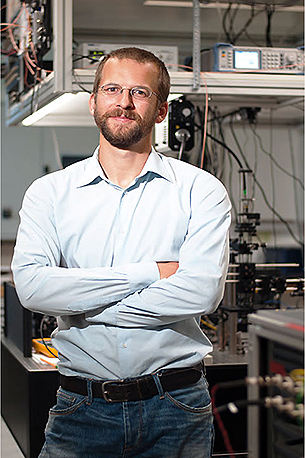Unravelling the Mysteries of Nanophysics with Spins and Diamonds
In a lab full of futuristic looking devices, Professor Patrick Maletinsky is working on transforming theoretical quantum mechanics concepts into technical applications.
That Maletinsky works in Basel as a professor of physics is down to a good chemistry teacher he once had: «Our chemistry teacher in the secondary school taught us a great deal about quantum mechanics. Ultimately, this field is the one that fascinated me the most.» Maletinsky is one of the youngest professors in Basel, and he already has quite a formidable career to look back upon. After completing his studies and his PhD at ETH Zurich, he became a postdoctoral student at Harvard University in the United States, where he worked on the development of highly-sensitive methods for magnetic field measurement on a minuscule length scale. Maletinsky was appointed to hold the Georg H. Endress Professorship for Experimental Physics in 2012 and was promoted to Associate Professor in 2017, and Full Professor in 2021.
Maletinsky is head of the Quantum Sensing Lab at the Department of Physics and is one of over 30 professors of the National Centre of Competence in Research QSIT. His group is successfully working on the development of sensors based on quantum mechanical principles that can, for example, measure and image magnetic fields with high precision and resolution. Quantum physics is, to put it somewhat bold and simple, the physics of the smallest objects. Thus quantum physicists like Maletinsky spend their time exploring atoms, molecules and the like: «Me and my team are driven by the question of what beneficial technical applications can be realized with today's quantum mechanics». He sees these applications primarily in the area of sensors, or more specifically, quantum spin-based magnometers.
Maletinsky describes the fact that he now works in Basel as a research group leader as a fortunate coincidence: «My research fits in perfectly: on the one hand, it brought something completely new to the department at the time, and on the other hand, there are many mutually beneficial overlaps with the other research groups», explains the physicist.
Quantum microscope to study magnetic materials
With the goal to offer a quantum mechanical solution for high-precision measurements develop fundamental new technology using quantum mechanics. Maletinsky, together with then postdoc Mathieu Munsch, founded the start-up Qnami in 2017 with the goal of developing quantum mechanical solutions for high precision measurements. Within a few years, Qnami was able to securse significant investments and already in 2019 presented the ProteusQ device, the world's first and unique quantum platform for the analysis of materials at a nanometer resolution. Today, with the ProteusQ scientists and R&D engineers are developing more advanced materials for future applications in electronics or healthcare. Involved in Qnami are until today former researchers from the Department of Physics at the University of Basel, the Swiss Nanoscience Institute and the Paul Scherrer Institute (PSI).
Tracking down Van der Waals-Magnets
In 2019, Patrick Maletinsky received a Consolidator Grant from the European Research Council (ERC) for his research project «QS2DM – Quantum sensing of two-dimensional magnets». Quantum sensors developed in Basel will be used to investigate atomically thin magnetic systems with the goal of bringing the magnets closer to potential applications in spintronics. The ERC is funding the project for 5 years with approx. 2.3 million Euros.


